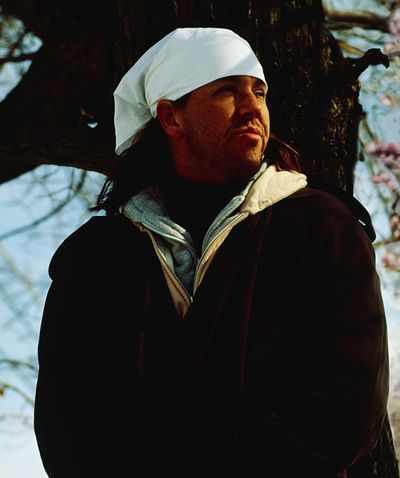Infinite Jest at 20

David Foster Wallace, 1996 �� Garry Hannabarger/Corbis
By ROBERT POTTS
David Foster Wallace's extraordinary 1000-page novel Infinite Jest is twenty years old this month. It was regarded as a classic almost on arrival, and the years have deepened and affirmed that status. It is significant that the TLS has returned to the novel on numerous occasions over the intervening period: as Thomas Meaney wrote, in 2013, "To be the distiller of the times for a generation is no small feat".
Bharat Tandon reviewed Infinite Jest when it was first published, in 1996. Despite the novel's density and complexity (the last 100 or so pages are end-notes which are sometimes highly illuminating, occasionally playfully unhelpful ��� "no clue" ��� and, on one occasion, completely blank), and its rambling, multi-styled sentences and paragraphs, Tandon identified most of the crucial features, including the link between a conspiracy theory culture and the reader's own acts of interpretation; the addictive nature of a book about addiction; and the debt to Thomas Pynchon. Tandon described Infinite Jest as "allegorical sci-fi, recasting and stylizing contemporary anxieties as the genre has always done", but concluded that it "never seems more than the sum of its weighty parts".
By the time of the tenth-anniversary reissue, Wallace's reputation had grown; he had not written another novel, but his short fiction and his essays showed a remarkable refinement of the themes and stylistic devices he had deployed in Infinite Jest. The game-playing could now be seen as intimately linked with philosophical, psychological and cultural anxieties; what seemed like heartless evasion was in fact a diligent manoeuvring around and towards some difficult and deeply heartfelt material. Stephen Burns, reviewing the reissued text, located the novel in its pre-millennial moment. He also picked up on the Joycean structure of the novel, in which the ostensible protagonist, Hal Incandenza, gradually descends into a Hamlet-like paralysis, while the unpromising figure of Don Gately, a drug-addict and criminal, steadily rises towards potential redemption: "Between the cynicism of youth and the developing sincerity of the recovering addict, Wallace attempts to explore what he calls 'the soul's core systems', probing his characters' sometimes nebulous sense of self". By now the incoherence Tandon had quite fairly criticized was mostly overlooked (barring some good quibbles about chronology) in favour of an admiration for the way in which the novel's overarching structure and (even at the level of a phrase or sentence) its diverse styles were a crucial part of its message.
Wallace hanged himself in 2008. The profusion of material that followed ��� previously unpublished manuscripts, criticism, memoirs, and so on ��� added new contexts; the addiction and self-consciousness that Wallace had presented as universal cultural and philosophical problems could be reduced to pathologies of the author himself. Paul Quinn's piece from last year deprecates the biographical turn in Wallace Studies. (Interestingly, none of our critics wondered whether one drive behind the writing of Infinite Jest might have been a testosterone-fuelled competitiveness ��� a boyish obsession with size and virility.) Wasn���t Infinite Jest also the capturing of a historical and cultural truth ��� what Quinn was able to call "Wallace's (and his generation's) defining work"?
The posthumous publication of the artfully assembled parts of Wallace's unfinished final novel, as The Pale King (2011), set in the 1980s in a rural department of the IRS, by sheer contrast further put Infinite Jest into its historical context. Quinn discusses Ralph Clare's claim that "Infinite Jest was the product of the 'Clintonian Golden Age' and 'the apparent fruition of neoliberal economics . . .' . The Pale King, on the other hand, was written 'during the exhaustion of the neoliberal promise', and 'returns to neoliberalism���s historical roots in the 1970s and its rise in the 1980s'". One might further note that as well as the economic crash, and the reassessment of value that followed, the events of 9/11 significantly reshaped aspects of the culture which Wallace had satirised in Infinite Jest. (The already comical terrorist subplot looks even more cartoonish in the light of twenty-first-century conflict.) Terrorism is treated with altogether more grimness in the short-story collection Oblivion (2004), albeit by Wallace's habitual use of suggestive tangents rather than direct engagement.
Twenty years on, Wallace's sprawling novel ��� a "battleship", an "encyclopedic behemoth", "gargantuan" ��� remains as powerful as ever. It had a profound influence on the novels that followed it, whether in imitation or conscious rejection. In style and intelligence it remains an unignorable challenge to readers and writers alike. But most importantly, beneath its brilliant stunts and set-pieces, it is a novel about sadness, about families, about the many barriers ��� psychological, socio-economic, technological, cultural, philosophical ��� between the self and others. It manages to be both hilarious and heart-breaking.
David Foster Wallace in the TLS:
The first review of Infinite Jest in the TLS: Bharat Tandon, 1996
Brief Interviews with Hideous Men: Lawrence Norfolk, 2000
On Oblivion: Stephen Burn, 2004
Consider the Lobster: Catherine Humble, 2007
The Pale King ��� "David Foster Wallace���s less-than-final text": Robert Potts, 2011
David Foster Wallace on Planet Trillaphon: Thomas Meaney, 2013
DFW reception: Paul Quinn, 2015
Peter Stothard's Blog
- Peter Stothard's profile
- 30 followers



